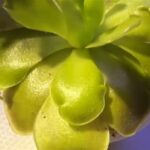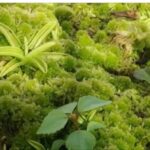As an Amazon Associate, this site earns commissions from qualifying purchases. For more details, click here.
Also known as the Balkanian butterwort, pinguicula balcanica grows in the sub alpine regions of the Balkan mountain ranges up to 8000 ft. This temperate butterwort can be challenging to grow, but not impossible. With the right approach you can cultivate a p. balcanica in your own home.
Pinguicula balcanica grows in partial to full light, preferably at a temperature range of 55-80 F. These plants require dormancy and can survive winter down to 20 F. During its growth period, the soil must always be moist and it has to feed every two to three weeks.
Pinguicula Balcanica Care Sheet
| Soil | 1:1 silica sand and peat moss |
| Water | Overhead watering, purified, distilled or rainwater |
| Light | Partial to full light, depends on species |
| Food | Flies, gnats, mealworms, fish food |
| Temperature | 55-80 F (12.7-26.6 C) |
| Humidity | At least 50% |
| Dormancy | Yes |
| Propagation | Leaf pullings, seeds |
Soil
Just like other carnivorous plants, p. balcanica grows in nutrient poor soil. Do not use fertilized or enriched potting media as it could be fatal to the plant. A typical soil mix for pinguicula balcanica is equal parts silica sand and peat moss. Sphagnum moss and perlite may also be used.
Most Balkanian butterworts are sold as seeds and may or may not come with soil. If there is an option to bundle the media, buy it. The soil will be ready to use and you just need to plant in a pot.
If you are growing p. balcanica seeds, use the same type of low nutrient soil. Let your butterworts get their nutrients from bugs, not the potting media.
You may also try other nutrient-free mixes like Perfect Plants Carnivorous Plant Soil. If the media is low in nutrients it should be safe for p. balcanica. Water as often as necessary to keep the soil moist.
Pot Container
Pinguicula balcanica needs a 3.5 inch pot to grow. Its small roots do not require a large container so it does not need too much space. You can use any pot or plastic cup even provided it is large enough.
Some butterworts are sold with pots so it is really not a big concern. As long as you take care of your p. balcanica and conditions are favorable, repotting may be unnecessary.
Like pinguicula acuminata, Balkanian butterworts usually do not need repotting. Once you have planted, the plant can stay in that container as long as it lives. However you may need to replace the pot if the plant grows larger than normal or the soil breaks down.
Repotting might help if your pinguicula has been infested too. Once you get rid of all the bugs and trimmed all the dead leaves, move the plant to a new pot with new soil.
Water
While growing, water pinguicula balcanica from the top until the soil is moist. Repeat when the soil starts to dry. Reduce watering in winter when the plant forms a hibernacula.
You can use the tray method during its growth period. Pour an inch of water in a tray and let the pot sit in it. Refill the tray as necessary. If you use the tray method there is usually no need to water from the top.
During dormancy you should reduce the water in the tray or water only from the top. Some growers like to keep their p. balcanica dry during this period. Others keep the plant as wet as it is during summer.
In general it is all right to water temperate butterworts in winter. But do not overdo this as it could induce rotting. When you buy a pinguicula it should include watering instructions. Use that as a guide.
Light
Some pinguicula balcanica species prefer partial light, while others thrive in full sun. Others grow better in natural light but there are those which adapt to artificial lights well.
Like pinguicula gypsicola and other butterworts, Balkanian pings need light. It might seem frustrating that the requirements can vary from one species to another. But as you handle these butterworts, you will eventually learn what works best for them.
If the temperature is ideal for pinguicula balcanica, you can leave it on a sunny window. Observe how the plant responds and relocate the plant to give it more or less light.
If your pinguicula looks pale and has non-sticky leaves, move the pot so it can receive more light. You can do this with artificial lights as well. We suggest Barrina Plant Grow Lights as a lot of carnivorous plants grow well with them. Once the lights are set up, give the plant a week or two to get used to it.
Signs of sufficient light are lush colors, sticky leaves, catching and eating a lot of bugs. You can tell by its appearance if a pinguicula is healthy or not. If it is, then the plant receives enough light.
Temperature
Pinguicula balcanica prefers cool temperature around 55-80 F (12.7-26.6 C). If you can keep the plant under 70 F that is even better, but the species can grow in 80 F. During winter, p. balcanica should be in 50 F (10 C) or better yet 20 F (-6 C).
During summer, p. balcanica should be in a warm, humid climate. Because these plants need dormancy they are best grown outdoors. Unless you live in a really hot region with 90 degree heat, you can leave this ping in your garden or a sunny window.
Temperature is crucial for p. balcanica because it needs winter frost to go into dormancy. Check the temperature in your region and if it is suitable, you should leave the plant outdoors in winter.
Some p. balcanica species can handle 85-90 F for a while, but prolonged exposure should be avoided. If your butterworts is outdoors, just move the pot under partial shade. Or you can just take the plant indoors and place it on a windowsill.
Humidity
In nature, Balkanian butterworts grow in bogs, streams and damp, rocky locations. These are humid places and suited for these plants.
For best results, pinguicula balcanica should be in at least 50% humidity. These butterworts might struggle in low humidity especially if the sun is out. You can increase it by watering more often or using a humidifier.
The key to growing p. balcanica is to provide warmth and humidity. These two elements will balance each other out. Too much heat without humidity is not good for temperate pings, and neither is high humidity with no warmth. As long as the humidity rate is at least 50% that is good.
Nutrition and Feeding
Pinguicula balcanica has to eat at last every 2-3 weeks. They usually feed on gnats, flies, ladybugs, ants and other small insects. But they will also consume bloodworms and fish food. Those are good for the plant because they contain the same nutrients that insects provide.
The feeding process is similar to pinguicula esseriana and other butterworts. Whether it is tropical, warm or cool temperate, these carnivorous plants usually eat the same prey.
You should only give food to pinguicula if the leaves are sticky. If the leaves are not, increase humidity around the plant and water it more. Once its glands start making mucus, you can feed it.
Butterworts should only be given food if they are unable feed by themselves. If you find bugs trapped in its leaves regularly, do not provide any more food. Your butterwort is getting enough nutrients as it is and do not need any more.
Dormancy
Pinguicula balcanica goes dormant in winter. The plant sheds its leaves and becomes a hibernacula. After winter draws to a close, the plant comes back to life and starts growing carnivorous plants anew.
Compared to tropical pings that form rosettes, p. balcanica goes through a typical dormancy. You may water the hibernacula but take care not to use too much. A bit of water helps if it is completely dry, but do not use as much as you would in summer.
As the temperature climbs up and your ping grows more leaves, water as you did before. It will not be long before its leaves start to produce mucus and catch bugs.
When winter ends, you can slowly start to water again. If you want to repot, do it before any new leaves sprout. Wait for the flowers to bloom in spring if you want to collect seeds for propagation. Once you have gathered the seeds, store them in 14-40 F (-10 – 5 C) for up to 12 weeks to germinate.

My fascination with carnivorous plants began many, many years ago with Venus Fly Traps. Now I am more than happy to impart what I know with other enthusiasts and those who are curious about meat eating plants.



